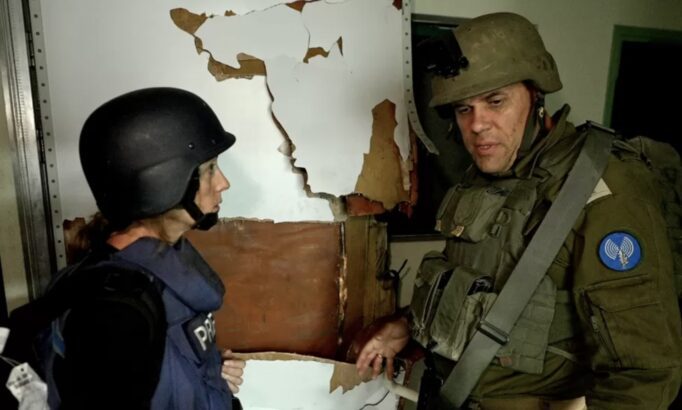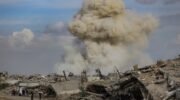Israel’s packaging of Hamas as barbaric butchers is losing momentum. An honest look at eyewitness reports, photos, and videos makes it clear that Israeli soldiers did some of the killing that day – and Netanyahu has been trying to keep that fact under wraps. Similarly, claims peddled by Israel and repeated by US media of Hamas committing horrific atrocities have turned out to be nonfactual war propaganda…
by Kathryn Shihadah
Apparently no one had any doubts about who perpetrated the horrific events of October 7th. Their identity was so “obvious” that Israel initiated a deadly war “against Hamas” that has killed roughly 12,000 Gazan men, women, and children as of this writing.
Biden and Congress have plans to give Israel $14 billion in “emergency” funding on top of the $3.8 it’s already receiving this year.
But what was so clear a few weeks ago has become more murky by the day, as journalists have interrogated photos, videos, and articles written in the early days after the attack for Israeli consumption.
While Israel may never reveal the full truth from that day, we as readers – and especially American readers whose tax dollars support Israel – need to be aware of as much truth as we can get our hands on. This is especially important, given that the “facts” of October 7th led to Israel’s decision to drop the equivalent of 2 atomic bombs on Gaza – with the support of many world leaders.
Here is one example from the Washington Post of a “fact” that was framed to serve Israel’s purposes:
We’ve recovered bodies [of] dozens of men, women and children. It’s clear to us that when [Hamas] went in [to the area], they just basically mowed down and murdered anyone that they found however they found them — in their cars and their houses.
~IDF spokesperson
The fact: dozens of bodies recovered.
The framing: Hamas murdered anyone they found.
Let’s examine facts not provided by Israeli spokesmen.
According to reliable accounts, the Hamas fighters that fateful day were lightly armed. Their “air force” consisted of hang gliders, their ground forces were motorcycles and pickup trucks. A video from CBS shows some of the weapons left behind – Kalashnikov rifles and rocket launchers, many of which are “40 to 50 years old,” and a mixed bag of hand-me-down rockets (Gazan rockets have killed a total of 47 people in the 22 years they’ve been used). No tanks. No drones. No humvees.
Extreme force – testimonies, interviews, and statements
Israeli soldiers were famously taken by surprise on that Saturday morning. The soldiers on duty rushed to the multiple battlegrounds with little or no knowledge of what they would find or what they should do. Their own statements confirm this.
From the first Apache pilots dispatched: As reported by Mako, a major Israeli news portal, “there was almost no intelligence to help [eight Apache helicopter pilots in the air] make fateful decisions.” One reserve pilot declared that as he approached the scene of the outdoor concert, “I find myself in a dilemma as to what to shoot at, because there are so many [people].”
Nevertheless, the pilots fired massive cannon and deadly missiles at anonymous people as they drove or ran. One pilot is actually reported to have instructed the others to shoot at everything they saw near the fence.
According to “Colonel E,” in one locale, “everyone who comes gets a missile in the head or shells.”
Another admitted afterwards that “it is almost impossible to operate fighter jets in our territory without greatly endangering the residents and [Israeli] fighters.”
Add in the admission, as reported by Mako, that “due to years of neglect,” the majority of the soldiers “did not know how to direct fire from the air.”
The following video, released by the Israeli military, gives us an idea of how events unfolded that day. (Trigger Warning [TW] – flashing lights)
Nevertheless, a total of 28 combat helicopters flew that day, each with a payload of 6-8 precision Hellfire missiles, as well as hundreds of 30mm cannon shells that are fired from the machine gun at the front.
Each helicopter emptied its ammunition indiscriminately onto the crowd below – unidentified people running, cars full of unidentified people, motorcycles – then returning to the base again and again to reload.
Neomit Dekel-Chen described her ride in a vehicle loaded with both Hamas fighters and hostages, as an Israeli helicopter shot at them. Both Hamas members and hostages were killed, though Dekel-Chen was spared.
Lieutenant E pointed out: “Look, usually when a helicopter goes on a mission, then it launches one missile, launches two, shoots a little shells. Here they come back empty.” Again and again.
Even Israeli media are beginning to accept the truth. Ha’aretz newspaper reported that a police investigation “indicates that an IDF combat helicopter that arrived to the scene and fired at terrorists there apparently also hit some festival participants.”
No wonder the road was lined with hundreds of wrecked and incinerated cars – cars that resemble those in Gaza hit in Israeli airstrikes.



When all was said and done, the Israeli Air Force was reportedly “convinced that if it weren’t for the aid fire and the many attacks carried out by IDF helicopter gunships that day – the [Israeli] carnage would have been much greater.” That statement is open for debate.
Israeli commanders order strikes that kill hostages
Israeli Security coordinator Tuval Escapa talks tank shelling: According to Tuval Escapa, the security coordinator at Kibbutz Be’eri, Israeli army commanders ordered the “shelling [of] houses on their occupants in order to eliminate the terrorists along with the hostages.”
Escapa explained that field commanders ultimately made the difficult decision to shell the houses with their occupants still inside, apparently alive – sacrificing the hostages in order to eliminate the enemy. “The price was terrible,” Escapa mused, “at least 112 Be’eri people were killed.”
Survivor Yasmin Porat on gunfights and tank shells: In several interviews, Yasmin Porat described how, outside the Be’eri house where she and about 11 others were held hostage, she heard “tens and hundreds and thousands of bullets and mortars flying in the air” between Hamas fighters and Israeli soldiers. When she went outside later, she saw that “they [had] eliminated everyone, including the hostages…Just like sheep to the slaughter. Undoubtedly,” she added, some of the Israeli victims had been killed by Israeli forces.
Eventually, “2 [Israeli] tank shells were shot into the house” – apparently referring to the house with 11 Israelis and a number of Hamas members still inside, just as Tuval Escapa had recounted.
According to Israeli media (reported by Reuters), “the [Hamas] militants killed at least 100 people in Be’eri. The Israeli army said it intervened and killed up to 100 Hamas gunmen.” This narrative, suggesting that Israeli soldiers gunned down only Hamas members, and all dead civilians were Hamas victims – doesn’t match eyewitness accounts.
The extent of the damage and carnage in Be’eri was shocking – except, perhaps, to those who have seen the aftermath of Israeli attacks in Gaza. Further, some of the damage again indicates much more powerful weapons than Hamas had.
The first two photos below were taken in Kibbutz Be’eri in Israel, the last two in Gaza.




Israeli general orders strike against his own soldiers
Airstrike at Erez Crossing: Among Hamas’ targets were the Erez Crossing – the only entrance into Israel – and nearby military bases at the northern border between Gaza and Israel.
An article in the Israeli daily Ha’aretz described what happened that morning:
A large Hamas force seized the adjacent Erez Crossing, which was closed for the Simhat Torah holiday. From there, within minutes and with no resistance, they advanced into the military base, killing and kidnapping the soldiers of the Civil Administration, though a few of them managed to return fire before being hit.
The Palestinian fighters moved on to the Coordination and Liaison Office. During the attack, the commander, Brig.Gen. Avi Rosenfeld called for an aerial strike against his own base to fend off the attackers – in other words, he ordered friendly fire against his own men and women as they fought their attackers.
Israeli soldiers on the ground fire indiscriminately
The grisly death of Niv Ayos: The mother of a young Israeli man named Niv Ayos told of how Ayos was driving to report for duty on Sunday, October 8, when Israeli forces misidentified him as a terrorist, and opened fire. His mother, a lawyer who intends to file a lawsuit over the incident, said that when she retrieved his car, “it looks like a pasta strainer.” The autopsy revealed that he’d been shot about 100 times.
Adi Ohana was killed in a similar incident. (His niece Rotem, a police officer, wondered why the police killed him. “Why not shoot the wheels? Why not shoot in the air?” – a question that Palestinian families in the West Bank often ask when their loved ones are abruptly gunned down by Israeli soldiers.)
Danielle Rachiel: Yet another street-level shooting involved Danielle Rachiel, who escaped with others from the Nova music festival in a small car. They were apparently traveling in the same direction as some of the gunmen who were carrying hostages back to Gaza. When Israeli security forces saw Danielle’s car, they began shooting. Luckily, she and her fellow passengers survived.
A Reuters report shows footage of bodies along a main road, with the description, “gunmen sprayed cars with bullets leaving some slumped dead in their vehicles and others sprawled on the tarmac.” Might some of these may have actually been, like Niv Ayos, victims of Israeli fire, or helicopter missiles?
Another (TW) disturbing video from South Responders shows the aftermath of a horrific attack – attributed to Hamas – for which Hamas did not have capabilities. The car, melted and filled with charred corpses, was most likely directly hit by a Hellfire missile, which Israel’s Apache helicopters used copiously (see above).
Humane treatment
Starting immediately after the October 7th attack, Hamas fighters were branded as “animals,” “ISIS,” and “Nazis.” On October 24th, the group got a bit of a makeover, thanks to a candid 85-year-old Israeli woman.
Yocheved Lifshitz: On October 23rd, Hamas released, for humanitarian reasons, 2 elderly Israel women who had been held hostage in Gaza. In a live press conference the next day, Yocheved Lifshitz, caused a “public relations disaster” when she recounted how her captors had shown “care” and “gentleness,” providing the hostages with food and medical care, and making sure their surroundings were clean and hygienic. In a video of her release, Lifshitz had made a point of shaking hands with her Hamas escort and saying “shalom.”

Yasmin Porat, whom we met earlier, also described being treated humanely throughout her captivity.
As the Hamas fighters guarded Porat and the others with her, they offered them drinks and tried to reassure them. One said to her in Hebrew, “Look at me well, we’re not going to kill you. We want to take you to Gaza. We are not going to kill you. So be calm, you’re not going to die.” She added, “It was very frightening but no one treated us violently…We were the ones who called the police together with the abductors because the abductors wanted the police to arrive. Because their objective was to kidnap us to Gaza. Not to murder us.”
Elsewhere, Porat said, “I was calm because I knew nothing would happen to me.” She added that they had loaded weapons, but she did not see them threaten or shoot any captives.
Another Israeli woman describes her experience, in which Hamas fighters spent several hours in her house, one of them promising her, “Don’t worry, I’m a Muslim, we won’t hurt you.” Later, one of them asked politely “May I eat a banana?” After 2 hours, they left.
Several thousand Hamas militants entered Israel that day, along with an unknown number of civilian tag-alongs. At least some of them apparently had more regard for the lives of Israelis than Israel’s own military did. While this does not absolve the group, it does fly in the face of broad-brush characterizations.
It is worth pointing out that Israel’s “targeted” bombing campaign has brought about the deaths of at least 50 of the hostages; Israel has also reportedly rejected offers from Hamas to release additional hostages.
Hamas hostage strategy
It appears that the humane treatment of hostages was part of a larger, relatively peaceful strategy.
Hamas leaders have been quoted as saying, “The plan was to target the [Israeli] army’s Gaza team and fight occupation soldiers only.” This lines up with the group’s actions on October 7th, when they attacked military targets (see “Israel’s Manual on the Rules of Warfare”). Teams strategically invaded multiple military bases, engaging with and killing Israeli soldiers – a legitimate target.
Another part of the plan was to kidnap civilians and soldiers to be brought back to Gaza for the purpose of a prisoner swap. Israel currently holds 7,000 Palestinians as political prisoners, and has agreed to such swaps in the past.
For example, in 2011, Israel had agreed to exchange one kidnapped Israeli soldier for over 1,000 Palestinians held in Israeli prisons. Gilad Shalit had been held for 5 years in Gaza, and had been well cared for.
In fact, Hamas as the political leadership in Gaza, has other demands for Israel besides the release of prisoners. Gaza has been under an official brutal blockade for 17 years (unofficially even longer), causing tremendous hardship for the people and an enormous humanitarian price tag for the international community.
It would also explain the experience of this resident of Kibbutz Be’eri: “I saw a group trying to enter my front yard. I opened fire and they replied with a burst. I don’t know why but they decided to go away.”
Obviously things did not work out according to plan. Ha’aretz reported on intelligence gleaned from several captured Hamas members, who revealed that
they had planned to seize control of a town or city in central Israel for a substantial amount of time and take its residents hostage. They also intended to plant mines in the area.
According to their accounts in interrogations, the plan went wrong because of confrontations with security forces, the communities’ guards, and civilians.
It is impossible to fully understand the events of October 7th without discussing the Hannibal Directive.
Israeli strategy: the Hannibal Directive
The Israeli military’s willingness to shoot indiscriminately from the ground and the air on October 7th, to blow up kibbutz homes with hostages inside – and currently, to bomb the whole of Gaza at great risk to the hostages’ lives – may be due to the application of a (no longer) secret Israeli war strategy.
The Hannibal Directive is a military policy that requires the use of maximum force if a soldier is being kidnapped. Former IDF soldier Yehuda Shaul explained, “You will open fire without constraints, in order to prevent the abduction” – even if it kills the soldier in the process.
The Israeli military denies it, but according to Shaul, there is an understanding among troops that a dead Israeli soldier is better than a living Israeli POW. Prisoner swaps, the military has learned, are demoralizing to troops and humiliating to Israel’s “national honor.”
Israel activated the Hannibal Directive in 2014, when Hamas fighters captured Lieutenant Hadar Goldin. The Israeli army, believing Goldin had been kidnapped, bombarded for ten hours a broad swath of the densely populated city of Rafah, where he’d disappeared. Between 135 and 200+ Gazans were killed. Max Blumenthal described the incident:
The target of the operation was not necessarily Rafah’s civilian population, though attacking it was part of the Israeli military’s underlying logic. Instead, the army apparently aimed to kill one of its own…[The Hannibal Directive] is a procedure aimed at preventing a politically painful prisoner swap by killing the captured soldier before he can be spirited away to a safehouse.
The Hannibal Directive might explain what happened on October 7th – and what has happened since. Rather than allowing Israelis to be kidnapped, Israeli commanders ordered strikes on their own bases, soldiers demolished homes on the heads of would-be hostages, and are now carrying out excessive bombing campaigns above the heads of Israelis held captive all over Gaza.
One could also argue that Israel’s military has a time-honored “shoot first” policy when Palestinians are involved.
Controlling the narrative
As is generally the case, Israeli spokespeople did most of the talking following October 7th. Israel rarely allows international journalists to enter Gaza, and Gazan reporters on the ground, with eyewitness accounts, are for the most part confined to alternative media outlets. Israel is not only the sole mouthpiece for the conflict, it is an active participant. It therefore takes effort to find the real story – more effort than most journalists are willing to make.
That may be why Reuters, for example, reported that “militants killed women, children and the elderly as well as young men and soldiers in their rampage.” The assumption that Hamas was responsible for all deaths that day was planted by carefully worded statements from the Israeli establishment early on. As British journalist Jonathan Cook points out, the media then repeated narratives crafted for them by the Israeli military without question.
Government sponsored tours: On October 10, it was Israeli military personnel who took members of the foreign press on a tour of Kfar Aza, where bodies still lay on the ground and buildings had been reduced to rubble. It was Israeli military talking points that they heard as they walked. More recently, Israeli soldiers took foreign journalists on a guided tour of the alleged “Hamas Command Center” under the Al Shifa Hospital. Attendees called it “underwhelming” and found it to be full of fabrications.
False claims of atrocities: On October 11, Netanyahu told President Biden: “They took dozens of children, bound them up, burned them and executed them. They beheaded soldiers, they mowed down these youngsters who came to a nature festival” (Israeli military spokesperson Lieutenant Colonel Jonathan Conricus “confirmed” the reports that Hamas had beheaded babies, commenting, “It is hard to believe that even Hamas could perform such a barbaric act”).
The same day, Biden told a group of American Jewish community leaders, “It is important for Americans to see what is happening. I have been doing this for a long time. I never thought that I would see… have confirmed pictures of terrorists beheading children.”
By the time it was revealed to be fake news, the image was burned into the world’s memory. There were many such false claims, often inciting rage among Americans who heard them and did not learn that they were untrue.
A show for NATO and Blinken: On October 12, the Israeli government gathered NATO defense ministers and US Secretary of State Antony Blinken to show them “graphic images of dead children and civilians…saying they were killed by Palestinian group Hamas.”
For Blinken, the photos proved that Hamas is “pure evil…It’s simply depravity in the worst imaginable way. Images are worth a thousand words. These images may be worth a million.”
US Defense Secretary Lloyd Austin came out of the meeting with a promise that Washington would not place any conditions on its military assistance to Israel, and expected Israel to “do the right things”.
All of this was, as Reuters described it, “part of an apparent effort to stoke global anger against the Gaza militants over Saturday’s attack.”
Film screening: On October 23, the Israeli government brought members of the international press together to view a 43-minute montage of grisly videos collected from various phones, dashcams, and security cameras on the day of the attack. That is, the Israeli government selected the footage, the audience, the setting, and the accompanying commentary.
Hollywood: On November 8, the Israeli government even had a screening for Hollywood entertainment industry leaders in Los Angeles – potentially bringing the Israeli narrative to the big screen.
The case of the disappearing photos: Max Blumenthal reported on 8 disturbing photos that were available online, courtesy of Israel’s ambassador to the UN. One photo “showed a pile of completely charred male corpses piled into a dumpster.”

Blumenthal suggests that these could not be Israeli corpses, which were always treated with respect and wrapped individually. These corpses must have been Hamas fighters who had been burned alive inside buildings along with Israelis.
Hamas fighters would not have burned themselves, and did not have the wherewithal. There are videos of Israelis defiling other Hamas corpses (TW disturbing video example here). Throwing them into a dumpster would be consistent with this treatment.
Blumenthal adds that a few hours later, most of the photos – including the dumpster full of bodies – had been deleted. He mused, “Had it been deleted because it showed Hamas fighters torched by a Hellfire missile, and not Israelis ‘burned to death’ by Hamas?”
Ages of victims: Israeli Prime Minister Netanyahu was adamant about the many children that Hamas (allegedly) brutalized and burned alive; for a while, he insisted that babies were beheaded – one “witness” had claimed to find 40 of them. Reuters, like other news outlets, quoted Israeli Major General Itai Veruv: “Mothers, fathers, babies, young families killed in their beds…Some victims were decapitated.”
Videos of broken and bloodied cribs and children’s bedrooms abound. But as the victim roll shows, only one infant was among the dead, and a relatively small number of children (about 12, while Gaza has lost at least 5,000 children, many of them infants, with 4,000 more missing and believed to be under rubble of destroyed houses). The vast majority were soldiers or security personnel, or Israelis of conscription age. But most of us will remember the accusations and bloody photos, not a chart.

A propensity for lying, and media fall for it
Space does not permit a full listing of Israel’s many official military and governmental lies.
In the weeks of bombing, we have heard lies about not only the beheading of babies, but also gang rapes, and babies baked in ovens. We’ve seen falsified videos of weapons caches, a bunker under the Al Shifa Hospital, a whispering nurse, and more. The bombing of the Al Ahli Hospital on October 17 may well be another lie.
In addition, as Chris Hedges points out in “Israel’s Culture of Deceit,
Israel blocks the work of independent human rights organizations into atrocities and war crimes it commits in Gaza and the West Bank. It refuses to cooperate with the International Criminal Court into possible war crimes in the Occupied Territories. It does not cooperate with the U.N. Human Rights Council and prohibits the U.N. Special Rapporteur on the situation of human rights in the Palestinian territories occupied since 1967, from entering the country.
Now, it seems that Israel got away with murder – until journalists with integrity began to uncover the truth. Yet, many of the false atrocity claims continue to circulate, and continue to be repeated by commentators.
Israel has on its hands the mingled blood of its own people and its neighbors.
Yet, Israel continues to push the US to give it billions more of Americans’ tax dollars, and we comply, making us accessories to war crimes. It’s time for this to stop.
Kathryn Shihadah is an editor and staff writer for If Americans Knew. She also blogs occasionally at Palestine Home.
RELATED READING ON THE CURRENT HOSTILITIES:
- Essential facts and stats about the Hamas-Gaza-Israel war
- What media reports fail to tell you about October 7
- More Palestinians killed in past 34 days than in the past 22 years combined
- Phones ringing off the hooks for a ceasefire, but Congress members aren’t listening
- US media say Israel is retaliating. The facts show the opposite
- US poised to give Israel $18 billion in aid this year
- Israeli communities near Gaza are on stolen land, former owners consigned to the Gaza ghetto
MORE ON ISRAEL’S LIES:
- Netanyahu purveyed a fictional history of Israel to Jordan Peterson
- Israeli Army’s Lies Can No Longer Salvage Its Image
- Israel arrests child with one-third of his skull missing, then lies about it
- The Six Day War and Israeli Lies: What I Saw at the CIA
- Israel lies after soldiers choke and kill Palestinian boy
- Peter Beinart: Jewish leaders encase Israel’s actions in Gaza in euphemism and lies
VIDEOS:
- What was happening in Gaza BEFORE the Hamas attack that the media didn’t tell you?
- Palestinian Rockets: The Hidden Facts
- Netanyahu, unaware of the camera, says ‘America can easily be moved’
- How Israel Betrays US
- Israel lobby’s false claims of “antisemitism” – Israeli journalist Gideon Levy
- Former Mossad agent describes falsely accusing Israel critics of “anti-Semitism”





